
|   |

|   |
Mukteswar Dance Festival - Dr. Sunil Kothari e-mail: sunilkothari1933@gmail.com Photos: Arabinda Mahapatra January 24, 2013 Hot on the heels of Rang Sopan festival (5 -12 June 2013) held at Bhopal in honour of theatre director Ratan Thiyam, the Mukteswar Dance Festival (Jan 14-16, 2013) was held at Bhubaneswar in the Mukteswar temple complex. Organized by Odisha Tourism Department, Govt. of Odisha with the initiative of Principal Secretary of Tourism and Culture Mr. Ashok Kumar Tripathy, who has since last two years, held various dance festivals successfully including Konark Dance Festival, Dhauli Kalinga Festival, Odissi International Dance Festival, in between Gotipua Festival and various music festivals of different parts of Odisha, with the result that Bhubaneswar in Odisha indeed has become 'a city of dance festivals.' I have been attending dance festivals in Bhubaneswar (and also at Cuttack) since last two years and am impressed at the attention given to minutest details personally by Mr. Tripathy, setting a very high standard for mounting dance and music festivals throughout the year with finesse, sophistication and thorough professional approach. Not only is the venue superb, be it Konark, Dhauli, Mukteswar, Raja Rani temples, or Rabindra Mandap, also the ambience is that of a festive mood – thousands of tiny blue lit bulbs, festoons, umbrellas, lamp shades of Pipli village hung tastefully from the branches of the trees on both sides of the streets leading to the venue, landscaping of temple gardens, stage, lighting, sound system, cameras held by DD TV, press photographers sitting in front, not moving all over, taking photos quietly without blocking the view of the audience, good arrangements for seating, good hygienic facilities, clean toilets, enough room for parking vehicles, courteous staff, security guards, ushers, professional comperes in Odiya, English and Hindi, latter by seasoned compere Sadhna Srivastav and for Odiya, Prof. Mrityunjay Mahapatra and E. Srinibas Ghatuary (Milan), with a team of artists including Guru Kelucharan Mohapatra's son, guru / performer Ratikant Mohapatra, Odissi exponent and Vice President of Odisha Sangeet Natak Akademi, Aruna Mohanty, Prof . Ram Hari Das, the celebrated vocalist and Professor in Music along with Sangeeta Gosain, reader in music in Utkal University of Culture, Chittaranjan Mallia, Secretary of Odisha Sangeet Natak Akademi, photographer Arabinda Mahapatra of Odisha Tourism Dept, polite staff of Odisha Tourism Dept and a host of other volunteers, looking after the needs of performing artists, stage management et al. I can go on and on, listing others, but suffice it to say that having attended various festivals for past thirty years including Khajuraho, Elephanta, Modhera, Mahabalipuram and other national dance festivals in different metropolitan cities and venues with architectural and temple edifices, I must say what Odisha has managed, leaving no stone unturned to make dance festivals 'festivals with distinction.' Mr. Tripathy deserves unqualified praise. The support he has been getting from the Ministry and his colleagues is amazing. None who attends these festivals has ever carried any unpleasant impression. He has paid personal attention to the artistes and taken over all responsibilities for successful organization which has resulted in ever increasing number of visitors both from within India and abroad. If I have written all this at length, there is a purpose in doing so. The readers might get a clear idea that Odisha has taken several strides and shall, if all goes well continue to progress. The bonhomie among performing artistes volunteering to work as a team inspires confidence amongst visiting artistes. It multiplies goodwill and bonding. Along with Leela Venkataraman, senior dance critic of The Hindu, I have been attending these festivals and covering them. She writes for The Hindu Friday page and I for narthaki.com for my column. And we have noticed these details from close quarters. We both have appreciated it seeing the sincerity and efficiency on part of all concerned. And we feel that Odisha offers a role model to other States and festival organizers. 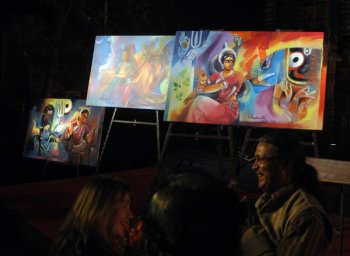
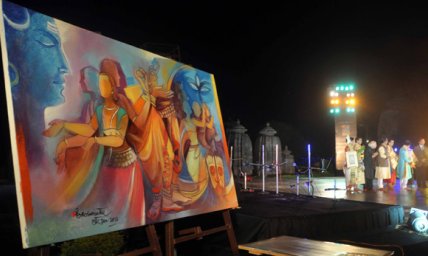
Mukteswar Dance Festival I have mentioned in my earlier reviews that Mukteswar Dance Festival was started by former Chief Secretary and scholar Subas Pani many years ago. I was at that time serving at Rabindra Bharati University in Kolkata as a Professor and Head, Dept. of Dance. I have happy memories of the first festival when Guru Kelucharan Mohapatra used to conduct puja at the shrine on the left (when we face the stage) of Ganapati and the lamp used to be brought to light the inaugural lamp for the function. That tradition is carried on by Mr. Ashok Kumar Tripathy. It lends the entire function an auspicious touch. The festival starts on the dot at 6pm and DD cameras are on. With introductions first number Shiva Vandana by a group of musicians is presented followed by a solo Odissi dance, then a duet by male and female dancers, or two male dancers and in the end Odissi group presentation. This format has been worked out well and within the time limit of two and half hours, the evening performances are over. Jan 14: During the opening of the festival, the Ambassador of USA, Ms Nancy Powell was the chief guest and other foreign dignitaries accompanying her. She was invited to light the ceremonial lamp. The opening was a prayer by Tulasidas rendered by the students of Utkal Sangeet Mahavidyalaya. The music was composed by Vijaykumar Jena. The sound of the conch and the chorus with Chidakasham bhaje Om Om filled the air with auspicious feelings. Sangeeta Das, an outstanding disciple of Guru Deba Prasad Das and Durga Charan Ranbir performed a specially choreographed number based on Vedasarashiva stotra, extolling the divine attributes of Lord Shiva. She interwove two sancharis of epithet of Lord Shiva as Nilakantha, drinking poison and another one of Lord Vishnu taking form of Mohini and offering elixir to Devas, when Rahu stealthily hides behind the Devas and drinks amrit, knowing which Vishnu sends sudarshan chakra to behead him and he runs taking shelter behind Lord Shiva and peeps from above the crescent moon resting on his matted locks. It was an unusual sanchari that Sangeeta later on explained to me. It was indeed an interesting episode. The next abhinaya piece was an oft repeated song of Banamali set to music by Ram Hari Das in Kirvani, "Mohane deli chahi ago priya sahi" - O dear friend when I saw Lord Krishna I was mesmerized. Could not move, so entranced was I. Sangeeta enacted with complete involvement and conveyed the impact of Krishna's beauty on the gopis. It had an old world charm. Sangeeta is based in Puducherry in the South and runs an academy of Odissi dance. She needs to be seen more and present rare gems of Deba Prasad Das's legacy. 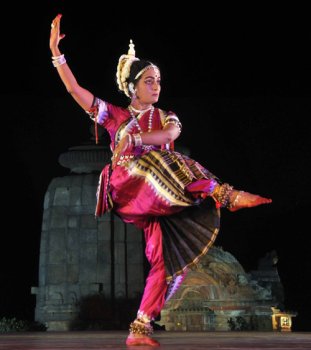 Sangeeta Das 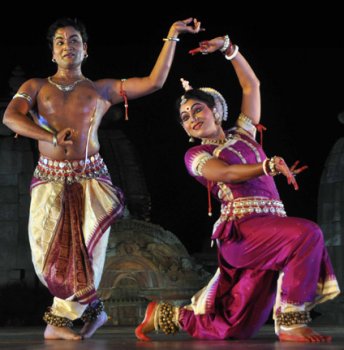 Lingaraj Pradhan & Sanjukta Dutta The duet by Lingaraj Pradhan (disciple of Gangadhar Pradhan and Bichitrananda Swain) and Sanjukta Dutta (disciple of Yudhishtir Nayak and under supervision of Gangadhar Pradhan) consisted of Hansa Kalyan Pallavi, music composed by Ram Hari Das, sung by Rajendra Kishore, mardala by Bijay Kumar Barik, flute by Jawahar Mishra, and stood out for their synchronized movements and perfection. It was well coordinated with good resolutions of final movements creating pleasant visuals. At times dancing individually to the rendering of solfa syllables like jugalbandi, the treatment enriched the pallavi. Often holding Darpani pose with one arm and coming together with two arms, as a couple, the performance stood out for Bichitranand Swain's imaginative approach. The next Bhavani Bhujang stotra in Hamsadhwani as a prayer by Shankaracharya had rich images, suggestive narrative to epithets like trinetra, turning Kamadeva into ashes, Lingaraj sitting on the floor, Sanjukta standing at the back, showing flowing river Ganga from the matted locks et al had economical touches, offering the choreographer ample scope to explore visuals. The Sanskrit poetry was so rich that in terms of description of the divine being it enriched the images in a seamless manner. Ghanasnigdha dhamilla, the coiffeur of Parvati, chalatakundala, dangling earings, bhramara bhringa, the bees drawn to the dark hair, bhushojwalanta, effulgent, sfuratmauli manikya, sparkling ornament on head and so on, the evocation of the divine pair was graphic and pleasant.
The finale was spectacular group presentation choreographed by Aruna Mohanty, narrating the story of evolution and development and growth of Odissi dance form, with historical perspective and temple background. Maharis, Gotipuas, various strands which contributed to its contemporary form by the gifted gurus, and in the end narrating story of Ramayana. The tiny tots, the Gotipua boys dressed as girls and performing with heart stealing charm, the young maidens entering in a diagonal covering stage and performing with sculpturesque beauty spoke volumes for Aruna as a choreographer able to handle group compositions with complete command over entries and exits of dancers, keeping attention of spectators glued to unfolding of kinetic images. Ramayana as a theme invariably appeals to audiences as it is a shared tradition striking emotional chords. Drawing from Prahlada Nataka, Giti Natya, Odissi has developed drawing inspiration from larger corpus of performing arts of Odisha. When dancers treat episode of Surpanakha for hasya, of late I have been feeling that it should be replaced by antics of army of monkeys when they build the bridge. It would help in avoiding unpleasant female depiction of Surpanakha. Ramayana offers many key incidents for navarasa depiction and shift in its interpretation instead of stock events would be appropriate. Kedar Mishra who has been associating with libretto would do well to explore this aspect. The evening concluded with joyous mood and also offered a large contingent of Orissa Dance Academy artistes, an opportunity to participate in the festival. Jan 15: Since Mukteswara's principal deity is Lord Shiva, artistes invariably included prayers and compositions of Adi Shankaracharya for opening stuti and in thematic content in dance. Prafull Kar is a seasoned senior musician. His musical treatment of Shiva Vandana Bhaja re manas Shaivapadam was melodious, unencumbered and pleasant to the ears. Shambhu Digamabara, Shashanka shekhara, Naga nageshwara, Jagadishwara Jayamukteshwara, epithets still ring in my ears. Solo presentation by Prof. Naba Kishore Mishra of Kaivata Prasanga (in which a boatman refuses to ferry Lord Rama across the river, unless he agrees to let him wash his feet, as the boatman fears that when Lord Rama's feet even touch a stone, it turns into a woman) has been reviewed by me earlier in Meera Das's festival in Cuttack November last year. Trained by Dr. Minati Mishra and Guru Deba Prasad Das, Pankaj Charan Das at Utkal Sangeet Mahavidyalaya, he had the benefit of working under supervision of Sanjukta Panigrahi. His treatment of Kaivat Prasanga reminds one of a similar number by Guru Kelucharan Mohapatra. Naba Kishore performs with intensity and manages to evoke Kaivat's persona. It is well presented with sincerity. What would help Naba Kishore is to tone down lokadharmi element and take care in make-up. Because of special lighting which poses problem as the performances are telecast live, the use of powder gives visage a bland look. Devoid of make up with natural skin, the impersonation of Kaivata would be effective. 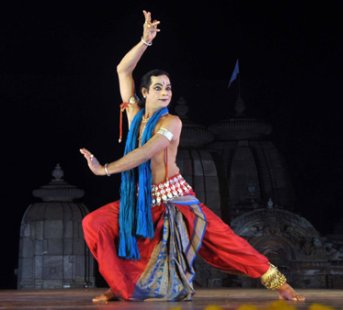 Prof. Naba Kishore Mishra 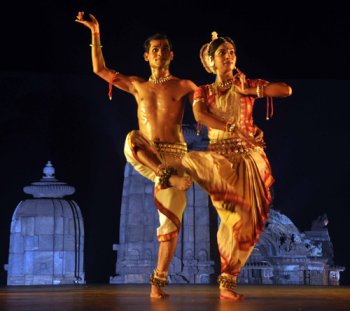 Biswabhushan Mahapatra & Rashmi Raj Duet by Rashmi Raj and Biswabhushan Mahapatra from Bangalore evoked nostalgia with Sankarabharanam pallavi. Rashmi Raj has received training at Orissa Dance Academy under Guru Gangadhar Pradhan and Aruna Mohanty and later on she studied at Nrityagram under Bijayini Satpathy. Similarly, after studying under Ashish Kumar Das, Biswabhushan joined Nrityagram. He and Rashmi Raj have acquired the stamp of 'Nrityagram bani' with attention to costumes and graceful movements. Their movements, at times one facing the audience, the other with back to audience, created mirror images and with perfect chauka, graceful tribhanga, griva chalana, neck movements, taking chauka bhramari, pirouettes, moving on heels backwards, they projected Kelubabu's choreographic marvel engaging attention of the audience. Shivapanchaka of Shankaracharya choreographed by Guru Gangadhar Pradhan to the music composed by Balakrushna Das, explored physical attributes of the Lord and both of them in kinetic language created sculptural images: adorned with ornaments effulgent, be that ear ornaments or necklaces, a crescent moon on jata, Lord wielding a trident, Nandivahana, with his vehicle Nandi, expert in Tandava and so on, the dance gathered momentum as music progressed. The musical accompaniment was adequate, unobtrusive and enjoyable.
Kolkata based Poushali Mukerjee, a disciple of Kelucharan Mohapatra and an expert in playing mardala has also won considerable fame for choreography. She chose to present with her group a prayer in praise of Goddess Kali. There were impressive flashes of choreographing procession and multi armed goddess with two male dancers, alternating with female dancers. The use of sabdaswarapata, depiction of samharamurti, Kalika described as 'suranaramuni asurasevi', 'muktidayini', whisk bearers waving fly whisks, when Goddess is taken in a procession etc, looked impressive. Poushali had selected a sequence from Chhanda of Sita Swayamvara of Upendra Bhanja, Bibhushana pushpe ja kanti jana, a part of Baidehi Bilasha ascribing choreography to Kelubabu. However, it did not work well as at times it appeared that all dancers were performing the same stanzas together, which looked odd. Pallavi as a group presentation was composed by Debashish Sarkar using Miyan Malhar raga and eka tala. The vocation of monsoon was attempted. Whereas the two male and two female dancers executed the movements competently, other group of girls on either side watching monsoon, lightning, responding, somehow looked lop sided. Poushali would do well to re-choreograph the pallavi, integrating all dancers in a manner that the group movements look cohesive. Also the dancers of the troupe did not display uniform movements and at times looked weak. They need to work hard at Poushali Mukerjee Dance Academy to project a strong image. Jan 16: A musician and a singer of high repute Shantanu Kumar Mahapatra is a versatile music composer and a director. The prayer in praise of Lord Shiva was rendered competently by a group of female and male vocalists under his baton. It set the mood for the evening. The refrain with 'Shiva hi data, Shiva karunmaya param Bhrahma shashwat, parmeshwar deva vandita, Shiva hi purusha Shiva mangalamaya' created a devotional mood.
Sujata Mohapatra is a name to reckon with in Odissi. To write more about her gifts and flawless performance is like gilding the lily. Her stage presence is magnetic. It is obvious that Guru Kelucharan Mohapatra's training has been imbibed by her thoroughly and she projects his 'bani' style impressively. Mangalacharan with backdrop of lit up temple, resounding with 'Om kar Bindu samyuktam, dhyayanti yoginam, kamadam,mokshdam, Omkaraya namo namah' enhanced the devotional mood. Her Ravana stotra in Bhatiyari as choreographed by Guru Kelucharan Mohapatra had all the finesse even when Guruji's treatment of Tandava in her execution appears lasya oriented, full of grace. The resounding words like 'dhagat dhagat, lalat patta pavane, kishore chandra shekhare rati pati mokshadam' expect forceful movements to reflect vigorous element, but Kelubabu has, it seems kept the element of lasya as one sees in Sujata's execution. Sujata chose to perform Yugma dwandwa, original one performed by Sanjukta Panigrahi, to the music composed by Raghunath Panigrahi, re-choreographed by Ratikant Mohapatra, evoking memories of Sanjkuta and Raghunath's classic number. The element of jugalbandi, repartee by dancer to the musical notes, indeed holds the same charm and magic as one used to watch when Sanjukta and Raghunath used to perform. It is to the credit of Sujata that she performs it so successfully and gives glimpses into the creative gifts of Sanjukta and Raghunath. Ratikant's embellishments are unobtrusive and merge smoothly. Bravo Sujata. 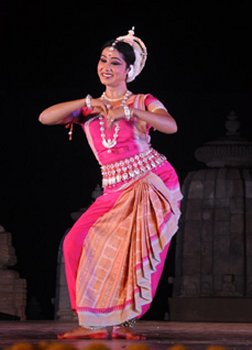 Sujata Mohapatra
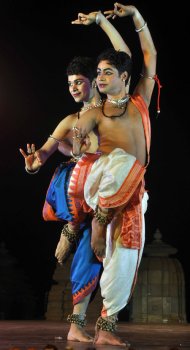 Debashish Pattanaik & Niladri Bhushan The evening also belonged to two young male dancers Debashish Pattanaik and Niladri Bhushan Mohanty, disciples of Durga Charan Ranbir. Debashish had earlier received training under Guru Kashinath Raoul and Niladri under Guru Pitambar Biswal, further enhancing Deba Prasad Das style under supervision of Durga Charan Ranbir. Their dance had complete synchronization of movements, which spoke volumes for Durga Charan's excellent training. The pallavi in Kirvani, set to music by Ram Hari Das in ekatali and to the excellent mardala playing by Dhaneswar Swain was performed with precision, technical excellence and confidence by these two young dancers and it seemed to me the audience was eating out of their hands. It indeed is fascinating to watch the impact that technical excellence generates. They danced in unison and seemed to respond to movements of each other, choreographed with an eye on balanced design. With a resounding applause from the appreciative audience no doubt was left in mind of anyone that both the dancers had won approbation from common men and cognoscenti alike. Bravo!! Adi Shankaracharya's Shivashtakam in Bhairavi raga and ekatali has been choreographed by Guru Durga Charan using all the powerful imageries and sound value of Sabdaswarapata: dimi dimi damru baje, naga bhayankara, murchhitavahni, nartanajata dhalanga dhalanga, garala halahala and so on. Vande Shambho Umapati, pranamami Shivakalpataru, Girirajasutanijavamatanu, replete with evocative images, the prayer found felicitous expressions in Devashish and Niladri's performance. Since Odissi offers scope for sculptural images, the dancers, one standing in front and the other behind with arms raised above and other spreading arms at lower level, creates four armed god's image beautifully. Durga Charan has a flair for it and some of the images linger long in memory. Their technique has polish and sophistication and at present their physic appears right for young dancers. They would do well to maintain it. They danced their way into the hearts of the audience. Be it pallavi revealing beauty of pure dance, or expressive number, the impact was highly charged for quality of dance. They did their guru proud.
The finale was by the Russian dancers led by Vitalina Lobach, who runs her institute Odissi Jivan Nrutya in Moscow for past fifteen years. Vitalina has received training under Madhavi Mudgal, imbibing style of Guru Kelucharan Mohapatra. They presented Jagannatha ashtakam of Shankaracharya, as choreographed by Madhavi Mudgal to the music composed by Sunanda Patanaik. All the dancers performed with admirable coordination and impressed the audience with their grammar of Odissi. Saveri pallavi choreographed by Kelubabu to music by Bhubaneswar Mishra had all those charming movements of chauka, tribhanga, holding arm near face like seeing through a veil, holding suchi hasta while dancing, and concluding movement with alapadma hasta, enacting shringara, placing necklaces, waist bands, sari, ankle bells, holding mirror in both hands, walking gracefully, creating strong visual images. The final number Dashavatara from the Gita Govinda, as choreographed by Kelubabu was performed by four dancers and other two joining in the end, describing the ten incarnations. They showed sincere approach with humility and it was a pleasure to see their dance with the backdrop of the beautiful Mukteswar temple. That art knows no barriers and bhakti transcends race, gender and national boundaries was evident. The Russian dancers' ability to master Odissi technique is commendable. Including them in this prestigious festival was a most welcome step on part of the organizers. That Odissi has acquired a global status is obvious. The organizers deserve congratulations for mounting such a wonderful dance festival.  Dr. Sunil Kothari is a dance historian, scholar, author and a renowned dance critic. He is Vice President of World Dance Alliance Asia Pacific India chapter, based in New Delhi. He is honored by the President of India with Padma Shri, Sangeet Natak Akademi award and Senior Critic Award from Dance Critics Association, NYC. He is a regular contributor to www.narthaki.com, the roving critic for monthly magazine Sruti and is a contributing editor of Nartanam for the past 12 years. Response * Bravo! Sunil Da. When a dance lover is deprived from attending an important festival like the Mukteswara, your vivid description gives extreme pleasure to the reader. Regards Monalisa (Feb 2, 2013) Post your comments Pl provide your name and email id along with your comment. All appropriate comments posted with name and email id in the blog will also be featured in the site. |